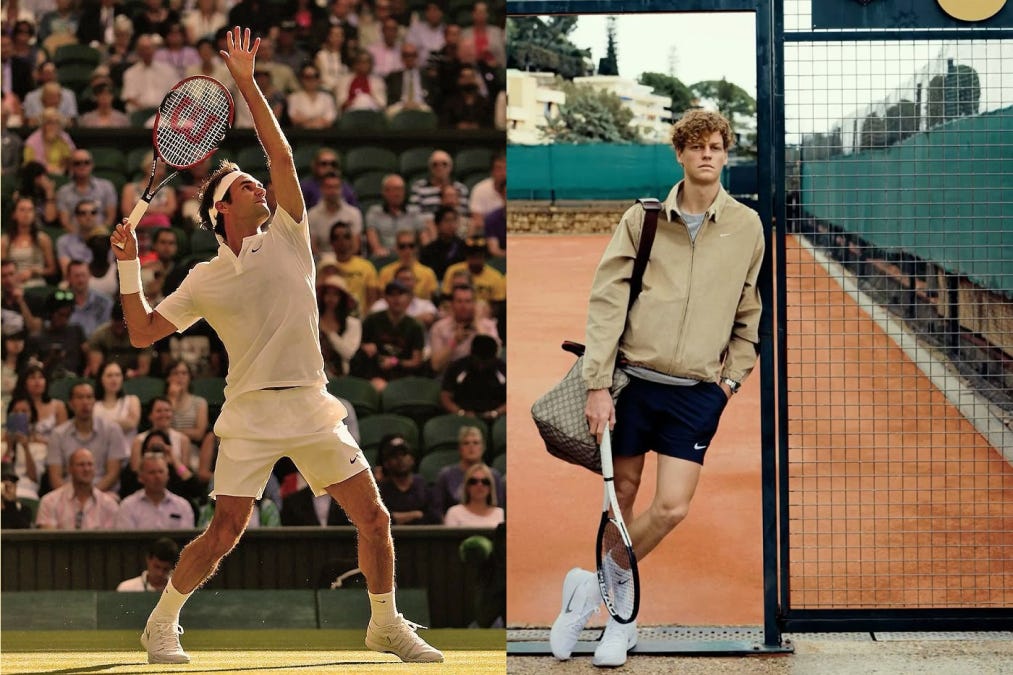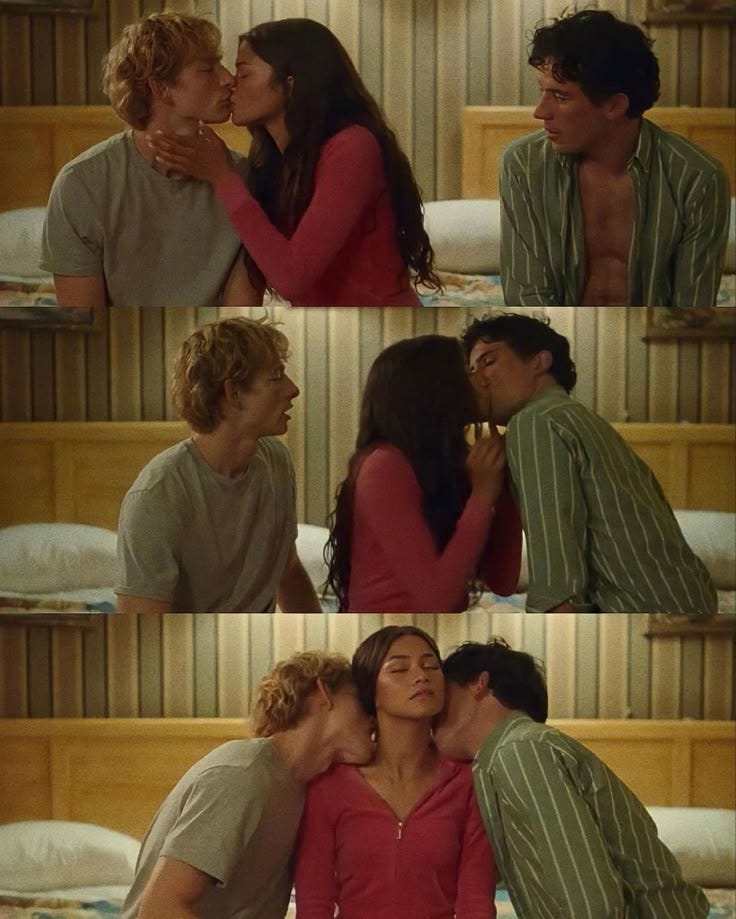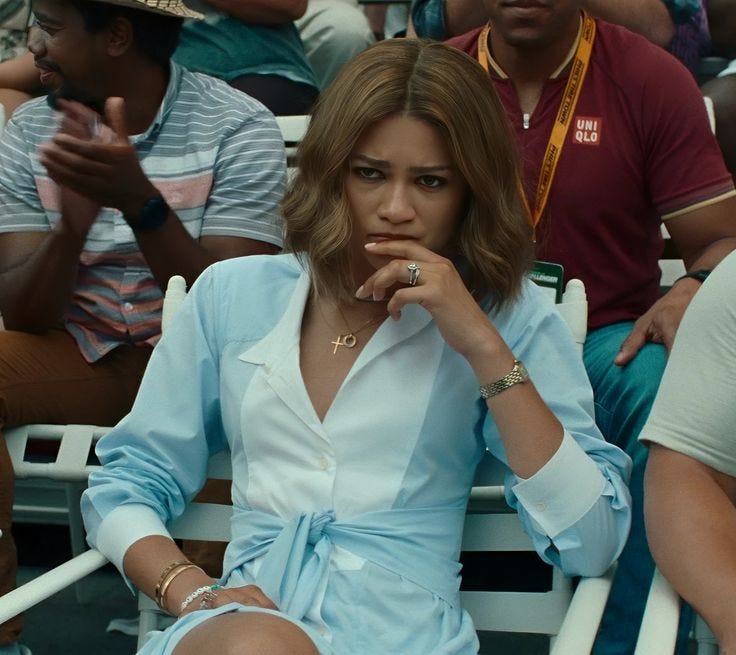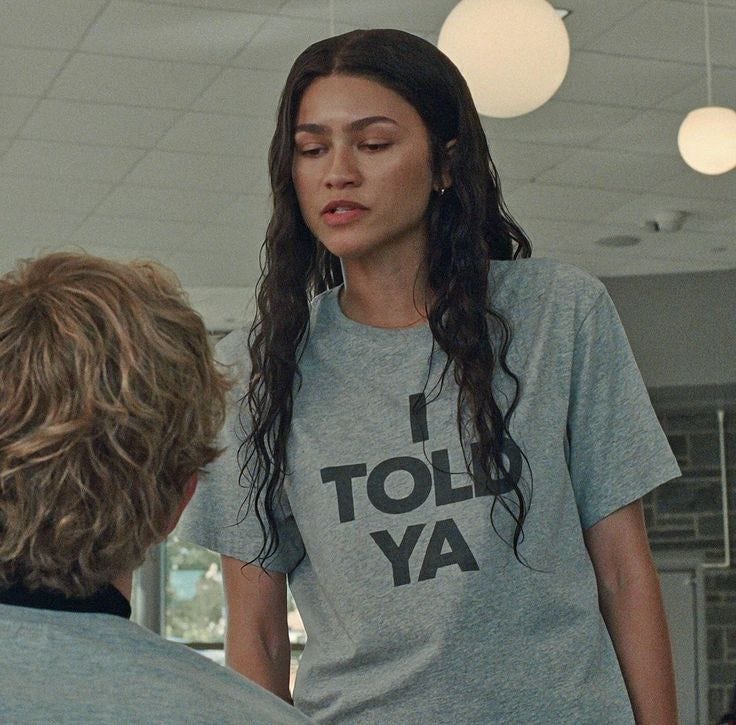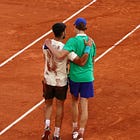Are we still talking about tennis?
Yes and no. Challengers, redefines how fashion brands integrate into cinema, crafting an aesthetic experience that feels both fresh and deeply relevant.
After last week's newsletter about the (poor) quality of fashion we witnessed at the F1 Movie Premiere in Times Square, we've been seeing countless promotional events for the F1 film, including the premiere in the UK. Since I haven't been invited to any of these events (yet), I still haven't had the chance to watch one of the most hyped films recently. I'll be able to report back after watching it whilst I'm in Sicily on a small holiday this week. Until then, my mind has been contemplating how these kinds of sports movies are special (I'm not discussing whether they're good or bad in cinematic terms) because they manage to intersect branding and culture seamlessly when executed well.
One of the finest examples that I rewatched a few days ago is "Challengers," a film by Luca Guadagnino that came out last year and, for me, marked a precedent on how a piece of culture like cinema can be the perfect tool to create brand relevance. I wrote an article about it last year, but since I didn't have Substack at that time, I thought I'd share it here as well, with some improvements and additions on fashion and art direction in a film that's now part of tennis core culture.
When Challengers was released, I expected it to evoke the same captivating atmosphere as Air—the film about Nike's Jordan story, directed by Ben Affleck. But in this case, it was even more intriguing to see how a tennis movie uses art direction and narrative to integrate real-world sportswear and luxury fashion brands, reflecting the modern intersection of sport with music, film, and advertising. Luca Guadagnino, renowned for his work on Call Me by Your Name, excels in this genre of filmmaking. In Challengers, he cleverly uses a love triangle between Art Donaldson (Mike Faist), Patrick Zweig (Josh O'Connor), and Tashi Duncan Donaldson (Zendaya) to draw compelling parallels between a tennis match and complicated personal relationships. Throughout the movie, the characters often ask Tashi, who narrates the story, if they're still talking about tennis.
Well, the answer is no.
Challengers delves deep into the realms of branding, brand storytelling, and pop culture whilst consciously "playing up the brands." Aesthetically, the film shines with meticulously curated cinematography and a striking colour palette. Rather than hiding or treating product placement softly, Guadagnino treats it as an authentic aspect of professional sports. Tennis is portrayed as a highly commercialised space, just like in reality, where every sport transforms each available space into the perfect billboard for brands — in tennis, particularly for fashion houses.
The constant presence of product placement may seem excessive to some, but it reflects our everyday reality. Look around you or think of a tennis match, and I bet you can easily name at least three brands in your view because they're now ingrained in our lives (consider how many logos and brands we consume directly and indirectly during a Formula 1 weekend). In Challengers, the brands do more than just advertise; they enhance the narrative and visual experience.
The film celebrates sports brands, particularly in fashion, with Adidas, Nike and Uniqlo, as well as luxury brands such as Chanel and Aston Martin, not only appearing but taking centre stage at certain moments whilst actively telling part of the story. This fresh approach points to the future of advertising, and while multiple brands often share a single frame, the integration feels neither intrusive nor artificial. Watching Challengers, you're acutely aware of the commercial elements, but they're executed with such flair that you don't mind.
One example is how the brands evolve with Tashi Duncan's character as she and her fame grow, as Merissa Lombardo, the film's product designer, explained. She transitions from street and oversized fashion during college to Chanel fitted dresses and designer accessories, adding a beauty routine with the famous Augustinus Bader cream that she applies before bed. The same happens with court kits, where we move from an early Adidas partnership to Nike, then to the Uniqlo white set worn by Art Donaldson during the final scenes, and of course, Wilson takes part in every racquet shown.
We had our dose of automotive with Aston Martin using a faux DBX707 advertisement campaign via giant billboards that, far from being mere advertising, acts as a recurring symbol to move the plot around Tashi and Art's marriage.
The Work of Jonathan Anderson
I know I'm not impartial here because if you know me, you know how much I adore(d) Jonathan Anderson's work at Loewe, which he managed to showcase brilliantly in Challengers as costume designer. One of the most interesting aspects is how he treated "sports as psychology," which I think is one of the most accurate terms to define it. A key driver of this concept is, of course, clothing and how it reflects an athlete's personal journey whilst subtly reinforcing brand identities.
With Tashi Duncan, he marked her evolution from her very teenage blue party dress, motivating her ambition and taste for fine things, but not yet possessing the refinement, to the pink Juicy Couture sweatshirt he used in one of the film's most iconic scenes. Looking at her in the present day, we can see how she uses a different palette and silhouette. Jonathan culminated her personal identity with a custom light powder-blue dress by Loewe, paired with Chanel espadrilles — the perfect definition of what we call quiet luxury.
Anderson explained that as Tashi grows older, "she becomes incredibly sophisticated. It's cashmere jumpers, the perfect luggage… And of course, the lighter blue. We talked extensively about her status and certainly about her power."
He played through fashion when portraying Art and Patrick's personalities as well, with the former having a clean and polished style with Uniqlo white fits in contrast to Patrick's careless and rough aesthetic. It's a way to communicate social backgrounds and personal careers without having to describe or narrate anything — purely through styling. To complete the narrative, Anderson had good help from music, a "pounding house score" by Trent Reznor and Atticus Ross that gives the film a club-like sensation.
“I TOLD YA”
One of the most iconic and powerful moves Jonathan made for Loewe through Challengers was with the "I TOLD YA" T-shirt that Zendaya wears in key scenes, demonstrating the romantic nostalgia between her and Patrick. It all originated when Anderson found a photograph of John F. Kennedy Jr. wearing a tee with that slogan, and he incorporated a replica of that shirt into Challengers. This again demonstrates the power of clothing, from JFK's '90s style to the fictional story of Tashi Duncan, blurring the lines between costume and branding whilst bringing clever but unforgettable marketing (something Tommy Hilfiger has replicated well with their collection for Damson Idris in the F1 film). Loewe made the definitive move from screen back to the real world when they released a limited edition of the T-shirt for sale.
"It's not about product placement; it's about the reality we live in, that we forget the wallpaper around us is made up of brands. When you see it, you realise how deep it goes."
- J.W. Anderson -
The film's promotional tour doubled down on this crossover appeal: Zendaya turned each red-carpet appearance into a "tenniscore" fashion moment. One of the standout fashion moments came during the film's press tour when Zendaya stepped out in a custom Loewe dress, complete with a pair of now-iconic heels with 3D tennis-ball embellishments — securing tennis and Loewe's place at the centre of the style conversation.
This shift in the narrative is largely driven by the growing influence of women both on and off the court. It's no coincidence that the film features a very female-driven narrative, with Zendaya at its centre, who wields significant influence in fashion (think of her as the face of Valentino, and recently tapped by On Sports Brand as their latest high-profile ambassador). Something particularly interesting considering Zendaya isn't an athlete, yet ON transformed her into one purely through the power she wielded as Tashi Duncan, again blending fiction with reality.
Influencer Morgan Riddle (@moorrgs) is a perfect example, successfully blending tennis, culture, and fashion brands together to highlight the power of emerging WAG culture.
We live in an era dominated by pop culture and fandom, where sport is emerging as the perfect platform for brands, especially in luxury fashion and beauty. Sport has always served as a springboard for brands to achieve iconic status, such as Nike's most legendary partnership with Jordan, which transformed the sneaker industry forever. The synergy between athletes and storytelling creates something authentic and aspirational that people want to be part of. A revolution is underway in fashion, sport, and advertising, where becoming a cultural icon is no longer just a game for Adidas or Nike.
And indeed, we are talking about much more than just tennis.
See you next weeek!
Alba








